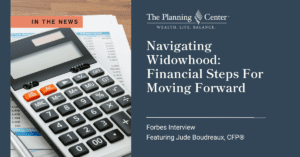By Cicily Maton, Retired Sr. Financial Planner
Cicily Maton has retired, however, Michelle Maton CFP®, EA, CeFT® Sr. Financial Planner and Andy Baxley CFP®, CIMA®, CeFT® Sr. Financial Planner carry on her legacy in the Chicago office.

Let’s start by defining asset allocation: it is the implementation of a strategy to balance the reward an investor is hoping for with the risk likely to be experienced. This balance is achieved by blending classes of assets in varying percentages. The traditional asset classes are stocks (equity), bonds (fixed income) and cash.
Most investors (and even a few of TPC clients) focus on individual assets, like an individual stock or mutual fund, or the S&P 500 Index. These investors follow the performance from quarter to quarter and sometimes day-to-day, agonizing over losses, or returns that don’t meet expectations. But decades of research indicated that the most important and impactful decision one can make is the asset allocation decision, and it is the first step of the Portfolio Management Principles at TPC.
Based on my memory, the first academic study published on asset allocation appeared in 1986, the year I began my career in financial planning. The Brinson, Hood & Beebower study concluded that asset allocation using indices explained an average 93.6 percent of the variation in total plan return. Although investment strategy can result in significant returns, these are dwarfed by the return contribution from investment policy, i.e. —the selection of asset classes and their weightings.
In subsequent years additional studies were published, some challenging, some validating, and some adding new elements to the asset allocation decision. A 2000 study by Roger Ibbotson and Paul Kaplan titled, “Does Asset Allocation Explain 40, 90 or 100 Percent of Performance?” was published. Ibbotson-Kaplan concluded that asset allocation explained 40% of the variation of returns across funds. In the next 20-plus years, many more research papers have been published. All differ in the factors that are included, time frame examined, and methodology use. But after all the years and the studies, the bottom line is that the asset allocation decision is the single most important decision, with the greatest impact, that you will make.
At TPC you are asked to participate in that decision making by discussing the important personal factors that help clarify your goals. Factors such as your time horizon, your age, your health, your life journey, your financial resources, your tolerance for risk and most importantly, your vision of the future all help in arriving at that asset allocation decision.
The difference between an all stock (equity) portfolio and an all bond (fixed income) portfolio is pretty obvious. An all stock (equity) portfolio will potentially have higher returns but will also have greater volatility. Volatility on the upside is terrific, but volatility on the downside can make one’s stomach turn upside down. On the other extreme an all bond (fixed income) portfolio will have lower potential gains, but it will not have movement up and down that will disrupt your ability to get a good night’s sleep.
Most investors will fall somewhere between these two extremes – between 100% Equity and 100% Bond. As life moves on and transitions occur, the asset allocation decision is revisited and adjusted to stay in tuned to you and your life.
One of the reasons a strategic decision like asset allocation can fail to work is simply human behavior and how we are naturally wired to make certain decisions automatically. Below are three common examples:
- The investor agrees to an asset allocation but after some bad returns, they decide they really want less risk, or
- The investor agrees to an asset allocation and after some very good returns, they now want more risk, or
- All investor behavior is biased. We all have biases that interfere with our rational decision making.
If you’d like to learn more about the strategies we’ve put in place to help manage these emotions and decisions, or if you’ve recently been through one of life’s transitions, maybe it is time to have a chat with your TPC advisor about your asset allocation. As always, we are here to help.





